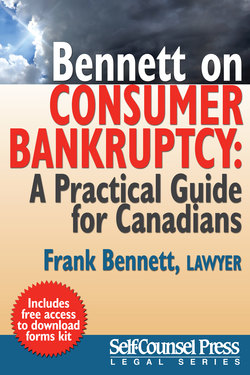Читать книгу Bennett on Consumer Bankruptcy - Frank Bennett - Страница 5
На сайте Литреса книга снята с продажи.
1. Defining Bankruptcy
ОглавлениеBankruptcy is a legal process which an individual debtor can take to protect himself or herself from creditors who are taking legal action to collect their accounts and debts.
Creditors may send letters and call the individual on a regular basis to pay the account, or more likely, creditors employ collection agencies who consistently call the individual. Ultimately, the creditor commences a lawsuit to collect, and if the individual does not have an adequate defence, the creditor obtains judgment. This judgment can be enforced easily through garnishment proceedings against the individual’s employer. This may finally force the debtor into bankruptcy.
Taking bankruptcy protection protects the individual debtor from further collection tactics. Bankruptcy involves a transfer of most of the debtor’s assets to a licensed trustee who sells them and distributes the monies amongst the debtor’s creditors. The debtor, however, can keep some exempt assets such as RRSPs. A debtor may be an individual person, a partnership, or a corporation. Bankruptcy wipes out, or releases most of the debts to creditors when the bankrupt obtains his or her discharge and allows the bankrupt to start all over again. The honest but unfortunate bankrupt person is generally entitled to a fresh start.
The bankruptcy process is governed by the Bankruptcy and Insolvency Act which is a federal statute. This statute was first enacted in Canada in 1919 and has been amended several times. The Act is the same throughout Canada and applies equally in Newfoundland and Labrador as it applies in British Columbia or in any of the territories.
The effect of taking bankruptcy proceedings is like waving a magic wand over the debtor’s creditors as it makes most legal proceedings to collect debts disappear. Taking bankruptcy protection relieves an individual debtor of his or her debts and provides instant relief and protection from creditors, collection agencies, and their lawyers who are suing the debtor. Taking bankruptcy protection stops collectors from collection agencies telephoning, faxing, emailing, and harassing the debtor. Taking bankruptcy protection stops employers from deducting monies from the debtor’s salary for the benefit of seizing creditors. For both the individual and the corporation, once bankruptcy happens, it feels as if a dark cloud over the debtor has lifted and disappeared.
After an individual goes into bankruptcy, creditors are generally prevented from taking legal actions against the debtor or against the debtor’s property. By operation of law, creditors are prevented from taking lawsuits, seizures, garnishments against the debtor’s wages, distress and similar related proceedings against the debtor without special permission of the court. The Bankruptcy and Insolvency Act provides an honest debtor with relief against overbearing creditors and affords the debtor with a second, and in some cases a third, chance to establish himself or herself.
Once a debtor takes bankruptcy protection, the process under the law also allows for the orderly and fair distribution of a bankrupt person’s non-exempt assets amongst all the debtor’s creditors according to a scheme of priority. Exempt assets are assets that the individual can keep if he or she files for bankruptcy. They would include, for example, tools of trade and household furnishings up to certain amounts, and registered retirement savings funds. Non-exempt assets for individuals are assets that are over and above certain thresholds. For example, the individual will be able to keep registered retirement savings funds except for monies invested within one year before bankruptcy. More about exemptions in section 6. and in Chapter 6.
The Bankruptcy and Insolvency Act sets out a priority scheme so that there is seldom any argument about the distribution of monies once the assets are sold. The provisions under the Act prevent creditors from scrambling to seize assets. It allows a debtor who is overburdened with debt, but has some assets, to transfer them to a trustee who will then sell and distribute the proceeds in a fair and equitable manner. This transfer of title to the assets happens automatically when the debtor takes protection. In practice, the consumer debtor rarely has any assets of value except for his or her salary. As a result, there is seldom any distribution of dividends to creditors. In short, bankruptcy allows the honest debtor to start all over again without the burden of debt.
